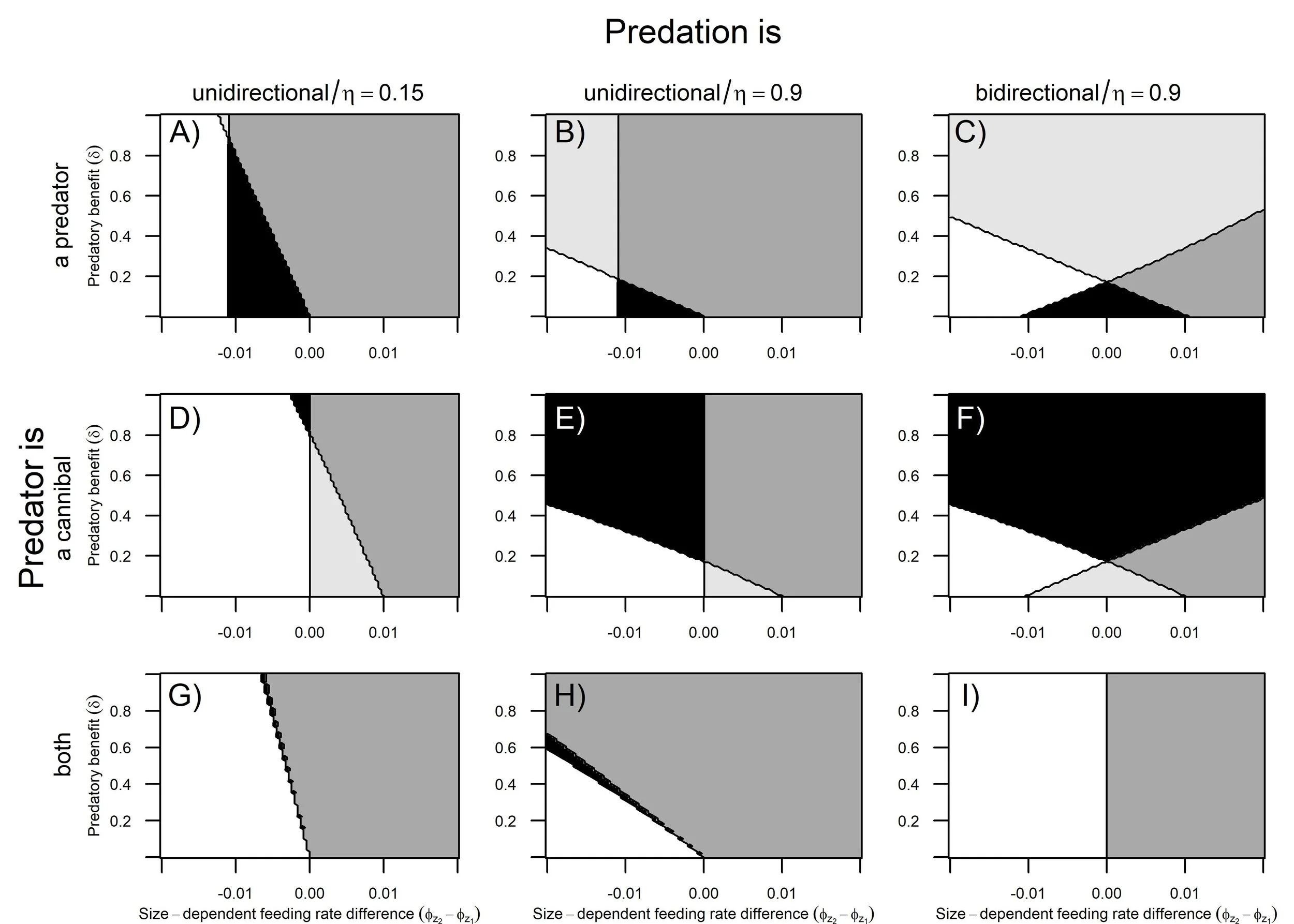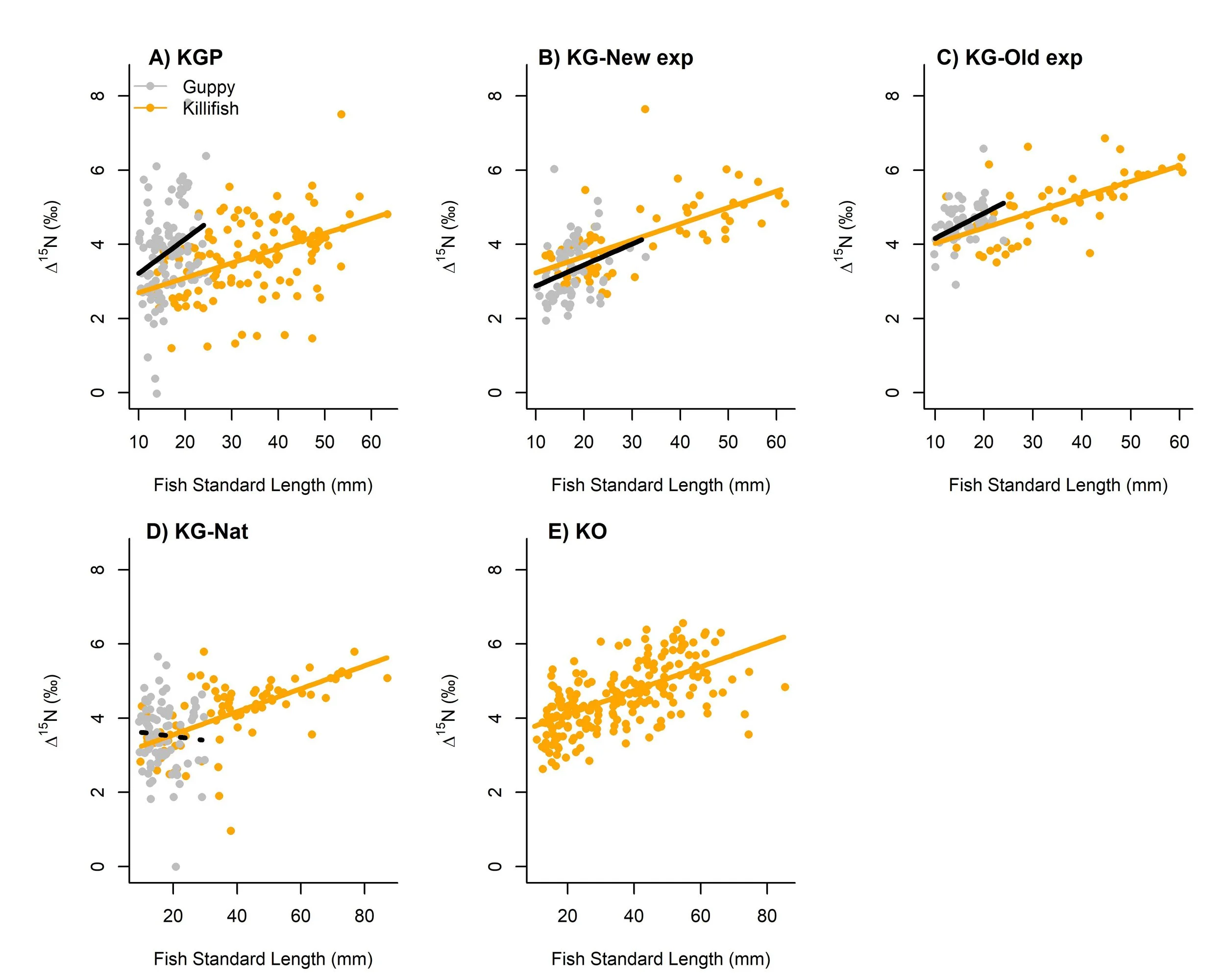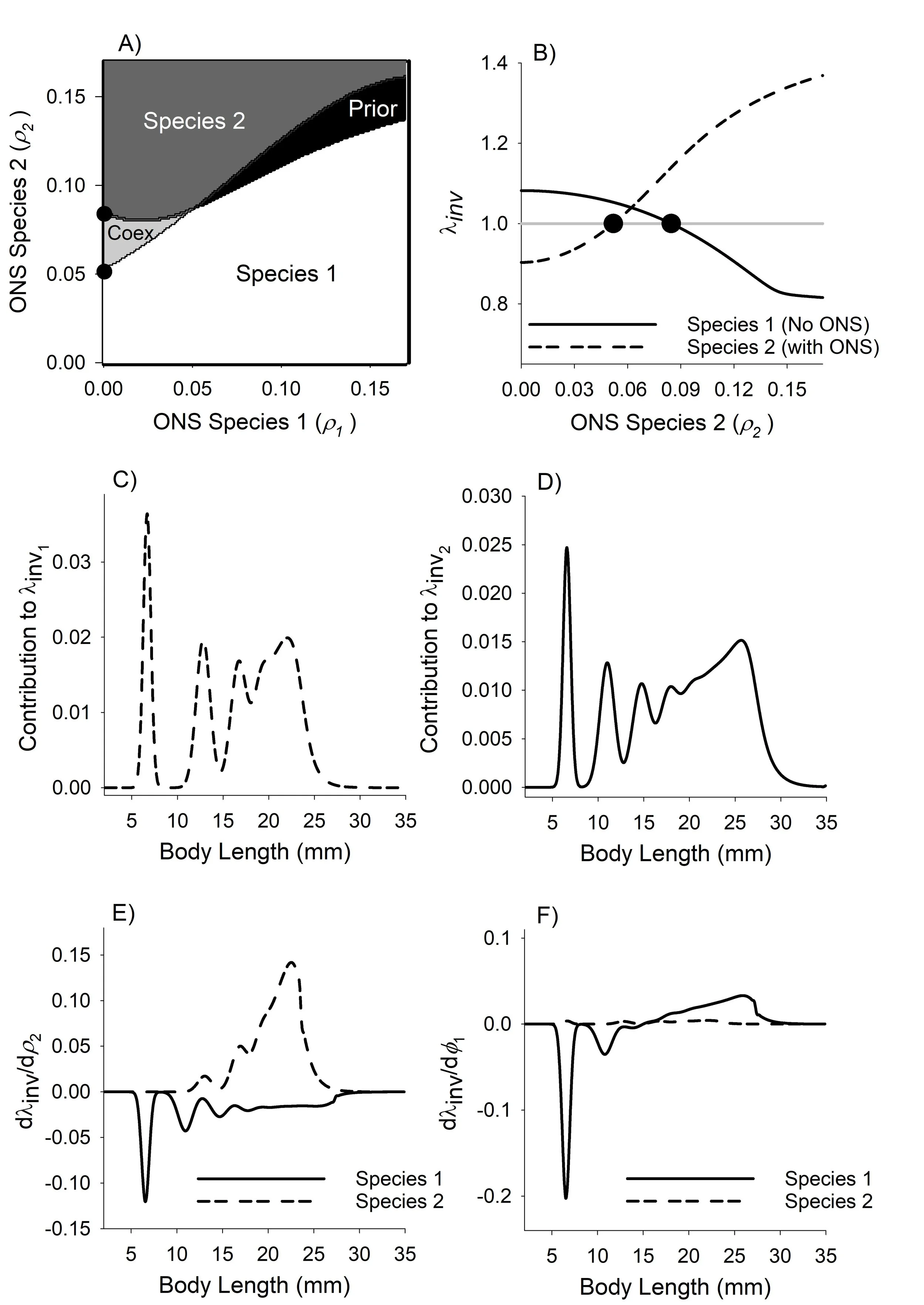Bassar, R. D., et al. (2023). Size-Dependent Intraguild Predation, Cannibalism, and Resource Allocation Determine the Outcome of Species Coexistence. The American Naturalist 201(5): 712-724.
Predictions for species coexistence, competitive exclusion, and alternative stable states when size-dependent predatory interactions involve one species being an interspecific predator, cannibal, or an interspecific predator and a cannibal (A, B, D, E, G, H) or both species are interspecific predators, cannibals, or interspecific predators and cannibals (C, F, I). The first row (A-C) shows the predictions when the predatory interactions are interspecific only (IGP). The second row (D-F) shows the predictions when the predation is intra-specific only. The third row (G-I) shows the results when the predator consumes inter and intra specific prey with equal frequency. The first (A, D, G) and second (B, E, H) columns show the predictions for when the predator devotes captured energy mostly towards somatic growth and fecundity or towards survival, respectively. For each plot, the y-axis gives the direct predatory benefit (conversion efficiency: ) ranging from 0, where the predator or cannibal does not consume the prey and hence does not directly increase in its survival, growth, or reproduction, to 1 where the prey are consumed and there is perfect transfer of resources from the prey to the predator. The x-axis gives the difference in the size-dependent feeding rate of the two species. Positive values indicate where the predator or cannibal in the unidirectional cases increase their feeding rate with body size to a greater degree than the other species. Negative values indicate where the predator or cannibal have lower feeding rates at larger sizes than the other species. White areas of the plots are areas where species 1 (the prey) can exclude species 2 (the predator/cannibal). Dark grey areas of the plots are where species 2 can exclude species 1. Light grey areas of the plots are parameter combinations where the models predict stable coexistence. Black areas of the plots show regions of priority effects where either species can repel invasion of the other.
Intraguild predation (IGP), a system in which species compete for resources and prey on each other, is more common than existing theory predicts. In theory, an IG predator and its prey can coexist if the IG predator is a weaker competitor for a shared resource and the predator directly benefits from consuming the prey. However, many species that are IG predators also consume members of their own species (cannibalism). Here, we ask whether cannibalism can help resolve the paradox of IGP systems. Our approach differs from previous work on IGP and cannibalism by explicitly considering the size dependence of predatory interactions and how the benefits of predation are allocated to survival, growth, and fecundity of the predator or cannibal. Our results show that cannibalism facilitates coexistence under conditions that are opposite of those predicted by standard IGP theory: species can coexist when the cannibal is a better competitor on the shared resources, directly benefits little from consuming conspecifics, and allocates resources from predation more toward growth and fecundity over survival. Because the effects of IGP and cannibalism are opposite, when an IGP predator is also a cannibal, coexistence between the IGP predator and its prey is not possible and instead depends on the operation of other coexistence mechanisms (e.g., resource partitioning). These results point to the importance of understanding the relative rates of IGP and cannibalism as well as the resource allocation strategy of the IG predator in determining the likelihood of species coexistence.
Effects of body size on the relative trophic position (site corrected Δ15N) of guppies and killifish from the five community types. Panel (A) shows the natural communities where guppies and killifish co-occur with predators (KGP). Panels (B) and (C) are the new and old experimental communities, where KGP guppies were introduced in 2009 (KG-E) and between 1976 and 1981 (KG-O), respectively. Panel (D) and (E) are the natural communities where killifish coexist with guppies (KG-N) and where killifish are the only fish species (KO), respectively. Black lines indicate linear regression for guppies; orange lines indicate linear regression for killifish. Solid lines and dashed lines represent significant (p<0.05) and non-significant slopes (p>0.05).
Anaya-Rojas, J.M., Bassar, R.D., Matthews, B., Goldberg, J.F., King, L., Reznick, D. & Travis, J. (2023) Does the evolution of ontogenetic niche shifts favour species coexistence? An empirical test in Trinidadian streams. J Anim Ecol.
A major question in ecology is how often competing species evolve to reduce competitive interactions and facilitate coexistence. One untested route for a reduction in competitive interactions is through ontogenetic changes in the trophic niche of one or more of the interacting species. In such cases, theory predicts that two species can coexist if the weaker competitor changes its resource niche to a greater degree with increased body size than the superior competitor. We tested this prediction using stable isotopes that yield information about the trophic position (δ(15) N) and carbon source (δ(13) C) of two coexisting fish species: Trinidadian guppies Poecilia reticulata and killifish Rivulus hartii. We examined fish from locations representing three natural community types: (1) where killifish and guppies live with predators, (2) where killifish and guppies live without predators and (3) where killifish are the only fish species. We also examined killifish from communities in which we had introduced guppies, providing a temporal sequence of the community changes following the transition from a killifish only to a killifish-guppy community. We found that killifish, which are the weaker competitor, had a much larger ontogenetic niche shift in trophic position than guppies in the community where competition is most intense (killifish-guppy only). This result is consistent with theory for size-structured populations, which predicts that these results should lead to stable coexistence of the two species. Comparisons with other communities containing guppies, killifish and predators and ones where killifish live by themselves revealed that these results are caused primarily by a loss of ontogenetic niche changes in guppies, even though they are the stronger competitor. Comparisons of these natural communities with communities in which guppies were translocated into sites containing only killifish showed that the experimental communities were intermediate between the natural killifish-guppy community and the killifish-guppy-predator community, suggesting contemporary evolution in these ontogenetic trophic differences. These results provide comparative evidence for ontogenetic niche shifts in contributing to species coexistence and comparative and experimental evidence for evolutionary or plastic changes in ontogenetic niche shifts following the formation of new communities.
Anaya-Rojas, J.M., Bassar, R.D., Potter, T., Blanchette, A., Callahan, S., Framstead, N. et al. (2021). The evolution of size-dependent competitive interactions promotes species coexistence. Journal of Animal Ecology, 90, 2704-2717.
Theory indicates that competing species coexist in a community when intraspecific competition is stronger than interspecific competition. When body size determines the outcome of competitive interactions between individuals, coexistence depends also on how resource use and the ability to compete for these resources change with body size. Testing coexistence theory in size-structured communities, therefore, requires disentangling the effects of size-dependent competitive abilities and niche shifts. Here, we tested the hypothesis that the evolution of species- and size-dependent competitive asymmetries increased the likelihood of coexistence between interacting species. We experimentally estimated the effects of size-dependent competitive interactions on somatic growth rates of two interacting fish species, Trinidadian guppies Poecilia reticulata and killifish Rivulus hartii. We controlled for the effects of size-dependent changes in the niche at two competitive settings representing the early (allopatric) and late (sympatric) evolutionary stages of a killifish–guppy community. We fitted the growth data to a model that incorporates species- and size-dependent competitive asymmetries to test whether changes in the competitive interactions across sizes increased the likelihood of species coexistence from allopatry to sympatry. We found that guppies are competitively superior to killifish but were less so in sympatric populations. The decrease in the effects of interspecific competition on the fitness of killifish and increase in the interspecific effect on guppies’ fitness increased the likelihood that sympatric guppies and killifish will coexist. However, while the competitive asymmetries between the species changed consistently between allopatry and sympatry between drainages, the magnitude of the size-dependent competitive asymmetries varied between drainages. These results demonstrate the importance of integrating evolution and trait-based interactions into the research on how species coexist.
Potter, T., King, L., Travis, J. & Bassar, R.D. (2019). Competitive asymmetry and local adaptation in Trinidadian guppies. Journal of Animal Ecology, 88, 330-342.
The outcome of competition between individuals often depends on body size. These competitive asymmetries can drive variation in demographic rates, influencing the ecology and evolution of life histories. The magnitude and direction of such asymmetries differ among taxa, yet little is known empirically about how adaptation to resource limitation alters competitive asymmetries. Here, we investigate the relationship between size-dependent competitive ability and adaptation to resource limitation. We examined size-dependent competition in two ecotypes of Trinidadian guppy, adapted to high or low levels of resource competition. Using aquaria-based competition experiments, we describe how the size and ecotype of competitors influence somatic growth rate, whilst controlling for the confounding effect of niche differentiation. We replicated our study across two independent evolutionary origins of the “competitive” ecotype. The two “competitive” ecotypes differed markedly in size-dependent asymmetry, indicating that adaptation to resource limitation alone is insufficient to explain changes in size-dependent competitive asymmetry. For one origin, the ecotype adapted to resource limitation was a superior competitor over a wide range of size pairings. The equivalence of competitors varied over fivefold, dependent on size and ecotype; in three of four populations, larger individuals had a competitive advantage. Our results demonstrate that competitive asymmetry has strong effects on somatic growth. Because somatic growth contributes to demographic parameters, intraspecific trait variation is likely to play a key role in regulating demographic rates. Our findings imply that the evolution of size-dependent asymmetries under conditions of intense competition is likely to be constrained by niche availability, although further research is needed to verify this.
Bassar, R. D., et al. 2016. The effects of asymmetric competition on the life history of Trinidadian guppies. Ecology Letters.
The effects of asymmetric interactions on population dynamics has been widely investigated, but there has been little work aimed at understanding how life history parameters like generation time, life expectancy and the variance in lifetime reproductive success are impacted by different types of competition. We develop a new framework for incorporating trait-mediated density-dependence into size-structured models and use Trinidadian guppies to show how different types of competitive interactions impact life history parameters. Our results show the degree of symmetry in competitive interactions can have dramatic effects on the speed of the life history. For some vital rates, shifting the competitive superiority from small to large individuals resulted in a doubling of the generation time. Such large influences of competitive symmetry on the timescale of demographic processes, and hence evolution, highlights the interwoven nature of ecological and evolutionary processes and the importance of density-dependence in understanding eco-evolutionary dynamics.
Bassar, R. D., J. Travis and T. Coulson. 2017. Predicting coexistence in species with continuous niche shifts and competitive asymmetry. Ecology.
For many organisms, resource use patterns change throughout development. Such ontogenetic niche shifts range from abrupt changes that delineate discrete life stages (as seen in amphibians or some insects) to continuous changes in niche use as a function of a trait linked to development (e.g. body size in many fishes, mammals, etc). Some organisms exhibit both (e.g. plants as seeds then adults, many egg-laying fishes, etc). Such ontogenetic changes lead to the structuring of populations into both discrete and continuous stages where individuals in one stage may compete with individuals in the same stage class and in different stages classes in contrasting ways.
Results of scenario 3 where we examine the coexistence of two species with the same life history where both species can shift or not, but each is a better competitor at different sizes—i.e. where competitive ability increases with size in species 1 and decreases with increasing size in species 2 ( ). As in other scenarios, newborns of both species share a niche ( ) and larger individuals of both species can shift to varying degrees with increased body size. The parameter value means that the two species are equal in their competitive ability at a size of 15 mm. Panel descriptions are the same as those in Figure 2. In panel A, white regions are combinations of ontogenetic niche shifts values where species 1 is predicted to exclude species 2. Dark grey regions are combinations of ontogenetic niche shifts where species 2 is predicted to exclude species 1. Light grey regions are combinations of ontogenetic niche shifts where the two species are predicted to coexist (labelled “Coex”). Black regions are combinations of ontogenetic niche shifts with priority effects (labelled “Prior”).
One persistent question associated with such complex life cycles is whether they promote species coexistence. In simple, two species models with two discrete life stages (e.g. larvae and adults), coexistence of the two species depends on whether one, or both, species shift their niche with stage, and which species is a better competitor in each of the two stages. For example, when one species shifts and the other does not, coexistence is possible if the species that does not shift its niche is a slightly better competitor than the one that does shift its niche. When both species shift their niches with stage, each species must be a better competitor in one of the stages, a worse competitor in the other stage and be mainly limited by the stage which is a worse competitor for coexistence to occur. In cases where this is not true, there may be competitive exclusion by one species or by whichever species initially occupies the habitat (i.e. it depends on the initial conditions). The above predictions regarding coexistence are valid for species with two life stages and there is no overlap in the niches of the two stages. However, the life stages of many organisms cannot be neatly categorized into discrete stages and instead are more accurately described by continuous changes in a trait that is related to niche use and competitive asymmetry. For many organisms this trait is body size. How coexistence theory built on discrete life stage changes translates into continuous life stages is unclear.
Here we develop a framework for analyzing coexistence in discrete time models with continuous traits that can be parameterized using data that are often collected by ecologists. We develop a general single-sex, two-species model of ontogenetic niche shifts where each species can shift its niche to varying degrees with development. To this model, we then overlay asymmetries in competition that are based on species or on body size. We then derive a general condition for coexistence in structured populations and, using an invasion analysis framework, ask how these two types of asymmetries influence predictions about coexistence. Finally, we use a perturbation analysis of the model to describe how different life stages contribute to the transition between competitive exclusion and coexistence.
Bassar, R.D., T.N.Simon, W. Roberts, J. Travis, D.N. Reznick. 2017. The evolution of coexistence: reciprocal adaptation promotes the assembly of a simple community. Evolution.
Local adaptation occurs when a population has higher fitness in an environment compared to allopatric populations in the same environment. Although there are many examples of local adaptation, there are comparatively fewer examples where we understand the selective mechanisms that cause these changes. Empirical studies of Trinidadian guppies have shown that guppies that live without predators have evolved different life histories than guppies that live with predators and that these changes occur over a few generations. However, we currently do not know the selective mechanisms that cause these changes. Early research focused on testing predictions from theory that are based on changes in mortality risk between the two populations in the absence of feedbacks between the agent of mortality and the ecological and evolutionary consequence (i.e. hard selection). Although many of the empirical patterns are consistent with these predictions, many are not. These results include a lack of the predicted age-specific mortality patterns between the two populations and results that show that guppies that live with predators show lower rates of somatic and reproductive senescence compared to guppies that live without predators. The latter of these two results are striking because it means that high predation guppies should always have higher fitness than low predation guppies. In short, HP guppies are super guppies.
Despite evidence that guppies that live with predators should have higher fitness than guppies that live without predators even in predator free environments, there is ample evidence that the LP guppies evolve rapidly from HP ancestors. So how do we resolve the paradox? A possible solution to the paradox involves incorporating feedbacks between the agent of mortality and the ecological and evolutionary consequence (i.e. soft selection). Bassar et al (2013) have shown using multiple independent origins of LP and HP guppies that density-dependent interactions within guppies go part of the way to resolving the paradox, but only if smaller HP guppies have higher mortality rates compared to LP guppies. These studies only considered interactions within guppies. Here we show that interactions with a possible intra-guild predator, the killifish, are essential to understanding the demographic mechanisms of local adaptation in this now classic example of local adaptation. Moreover, we show that these interactions depend on the phenotype of both the guppies and the killifish.


